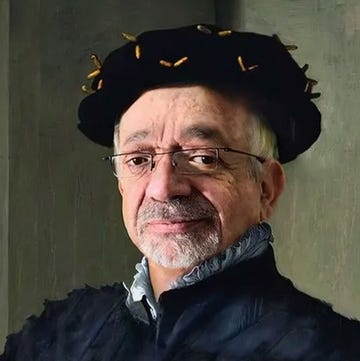We’ve waited too long for a full-length biography of legendary music journalist Ralph J. Gleason. Not that Gleason’s work has been neglected; his columns for the San Francisco Chronicle and Rolling Stone, where he famously championed the bands of the 1960s Haight-Ashbury scene, have guided music historians for decades, and Yale University Press issued two well-received anthologies in 2016. Now, almost five decades after Gleason’s death in 1975 at age 58, Don Armstrong has produced The Life and Writings of Ralph J. Gleason: Dispatches from the Front.
In this judicious and balanced account, Armstrong casts Gleason as a musical omnivore whose first love was jazz. The romance blossomed in the 1930s, when Gleason was a scholarship student at Columbia University. The surrounding neighborhood housed what one historian has called “the greatest assemblage of academic progressives and radicals in Depression America.” Gleason wrote for the campus newspaper, studied literature with Lionel Trilling and Mark Van Doren, read the New Masses, and haunted Manhattan’s jazz clubs.
After graduation, Gleason cofounded the short-lived Jazz Information, contributed to DownBeat, and worked for the U.S. Office of War Information. When World War II ended, he moved to Berkeley and eventually landed at the San Francisco Chronicle. Armstrong describes Gleason’s Chronicle column as “a milestone in music journalism history” that provided “an unprecedented depth of pop music coverage.” Syndicated in 1958, the column also ran in the Boston Globe, Philadelphia Inquirer, and Los Angeles Mirror News. Although jazz was Gleason’s primary focus, he also wrote about Hank Williams, Elvis Presley, Ray Charles, Odetta, Frank Sinatra, Sam Cooke, and Chuck Berry.
Once established at the Chronicle, Gleason created new platforms for the music he loved. One was the Monterey Jazz Festival, which he cofounded in 1958. The following year, he began hosting Jazz Casual, a public television program that hosted, among others, Duke Ellington, Count Basie, Louis Armstrong, and Dizzy Gillespie. National Educational Television, which preceded PBS, syndicated the show in 1962.
During that same time, Gleason also taped long interviews at his Ashby Avenue home with Gillespie, John Coltrane, Sonny Rollins, Quincy Jones, and others. He respected the music and the artists who made it, all the more so given the challenges of the Jim Crow era. That respect was often mutual. “Ralph Gleason,” Miles Davis said in 1975. “He understands me.”
Yet as Armstrong notes, Gleason’s rapport with musicians had little to do with celebrity. “I wouldn’t care if Miles and I didn’t get along—it happens that we do, but that could change,” he is quoted as saying. “The important thing is that I stay straight with myself.”
Gleason assembled a personal network that included journalist I.F. Stone, Allen Ginsberg, James Baldwin, and Marxist historian Eric Hobsbawm. He befriended comic Lenny Bruce and testified at his 1962 obscenity trial. Meanwhile, Gleason’s home became a salon not only for musicians, but also for young journalists and activists, including Greil Marcus, Michael Rossman, Denise Kaufman, and Jann Wenner, whose column in the Cal newspaper was modeled on Gleason’s for the Chronicle. The two of them would team up to launch Rolling Stone in 1967.
By then, Gleason had already written his way into and out of Ramparts, edited by Warren Hinckle. Indeed, it was Hinckle’s scathing takedown of the counterculture, “The Social History of the Hippies,” that led Gleason to resign in a fury, clearing the way for his collaboration with Wenner. Before the first issue of Rolling Stone ever hit newsstands, Gleason helped organize the Monterey International Pop Festival, the signal rock event of that summer. In addition to showcasing new talent, Monterey Pop was proof of concept for outdoor rock festivals and the films that would document them.
Gleason remains best known for raising the profile of Bay Area bands. After he devoted a column to Jefferson Airplane, RCA Victor offered them a recording deal. Other labels quickly signed the Grateful Dead, Big Brother and the Holding Company, and Creedence Clearwater Revival. Their success added to Gleason’s reputation, although, Armstrong notes, some critics claimed his support had crossed from journalism to promotion.
Gleason’s influence at Rolling Stone was immense and largely positive. His first column, on racist double standards in the media, helped distinguish the publication from many of the teen, trade, and rock magazines that preceded it. His reputation also meant instant credibility in the music industry, whose advertising dollars financed Rolling Stone’s rapid growth.
Equally important was his advice to Wenner to cover the disastrous December 1969 Altamont Speedway Free Festival “like it was World War II.” It was at Altamont that a fan named Meredith Hunter was knifed to death by a member of the Hells Angels as the Rolling Stones performed. The magazine’s hard-hitting coverage in an article called “Let It Bleed”—title borrowed from the album the Stones were touring—led to Rolling Stone’s first National Magazine Award the following year.
Gleason detested Richard Nixon and was the only music journalist on the president’s infamous Enemies List. But he also scorned what he called the unhip left. Politics was downstream from culture, he believed, and rock music was animating a social revolution already in progress. Such an idea, Armstrong suggests, turned out to be false, but it never occurred to Gleason that hippies (or anyone else) could win all the cultural battles and lose all the political ones.
Throughout, Armstrong documents Gleason’s life sympathetically and carefully. Noting his subject’s versatility, activism, and vast body of work, the author casts Gleason as a “cultural mediator” who “used his constantly expanding platform to legitimize critical breakthroughs that innovated American music and kept it relevant to an increasingly diverse audience.” If that assessment seems modest to some aficionados, The Life and Writings of Ralph J. Gleason furnishes everything necessary to fashion a bolder one.•
Peter Richardson is the author of critically acclaimed books about Hunter S. Thompson, the Grateful Dead, Ramparts magazine, and Carey McWilliams.













